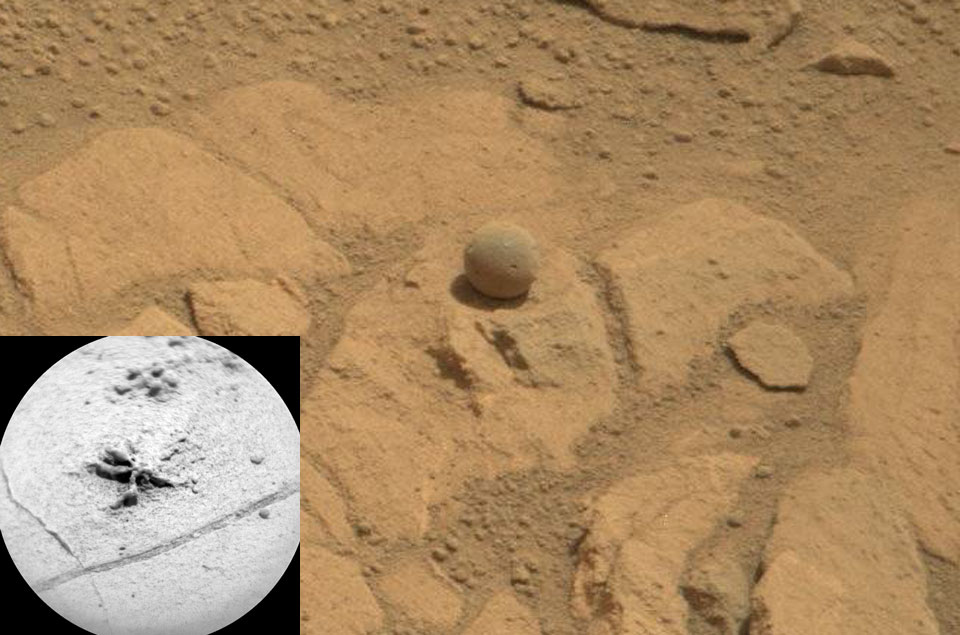Unusual Rocks near Pahrump Hills on Mars
Unusual Rocks near Pahrump Hills on Mars
Image Credit: NASA, JPL-Caltech, MSSS
Explanation: How did these Martian rocks form? As the robotic Curiosity rover has approached Pahrump Hills on Mars, it has seen an interesting and textured landscape dotted by some unusual rocks. The featured image shows a curiously round rock spanning about two centimeters across. Seemingly a larger version of numerous spherules dubbed blueberries found by the Opportunity rover on Mars in 2004, what caused this roundness remains unknown. Possibilities include frequent tumbling in flowing water, sprayed molten rock in a volcanic eruption, or a concretion mechanism. The inset image, taken a few days later, shows another small but unusually shaped rock structure. As Curiosity rolls around and up Mount Sharp, different layers of the landscape will be imaged and studied to better understand the ancient history of the region and to investigate whether Mars could once have harbored life.
Follow @ballaboocom
Solar Dynamics Observatory, Late Summer Solar Flare
On Aug. 24, 2014, the sun emitted a mid-level solar flare, peaking at 8:16 a.m. EDT. NASA's Solar Dynamics Observatory captured images of the flare, which erupted on the left side of the sun. Solar flares are powerful bursts of radiation. Harmful radiation from a flare cannot pass through Earth's atmosphere to physically affect humans on the ground, however -- when intense enough -- they can disturb the atmosphere in the layer where GPS and communications signals travel. This flare is classified as an M5 flare. M-class flares are ten times less powerful than the most intense flares, called X-class flares.
Image Credit: NASA/SDO
Follow @ballaboocom
Earth From Space, An Astronaut View
NASA astronaut Reid Wiseman tweeted this photo from the International Space Station on Tuesday morning, Sept. 2, 2014. "My favorite views from #space – just past #sunrise over the ocean," the Expedition 40 astronaut tweeted.
The Expedition 40 crew has been busy aboard the Space Station, recently performing health checks and humanoid robot upgrades. In the meantime, a trio of orbital residents is packing up gear as they prepare to return home in less than two weeks. Commander Steve Swanson powered down and stowed Robonaut 2 after wrapping up its mobility upgrades this week. He installed new legs on the humanoid robot including external and internal gear as well as cables. This sets the stage for more upgrades in the fall before Robonaut takes its first steps as an assistant crew member. Robonaut was designed to enhance crew productivity and safety while also aiding people on Earth with physical disabilities.
Image Credit: NASA/Reid Wiseman (@astro_reid)
Follow @ballaboocom
The Beat of a Midsize Black Hole (video)
NASA | RXTE Satellite Catches the Beat of a Midsize Black Hole -
Aug 18, 2014--Astronomers from the University of Maryland, College Park (UMCP) and NASA's Goddard Space Flight Center have uncovered rhythmic pulsations from a rare breed of black hole in archival data from NASA's Rossi X-ray Timing Explorer (RXTE) satellite. The signals provide compelling evidence that the object, known as M82 X-1, is one of only a few midsize black holes known.
Aug 18, 2014--Astronomers from the University of Maryland, College Park (UMCP) and NASA's Goddard Space Flight Center have uncovered rhythmic pulsations from a rare breed of black hole in archival data from NASA's Rossi X-ray Timing Explorer (RXTE) satellite. The signals provide compelling evidence that the object, known as M82 X-1, is one of only a few midsize black holes known.
Subscribe to:
Posts (Atom)



